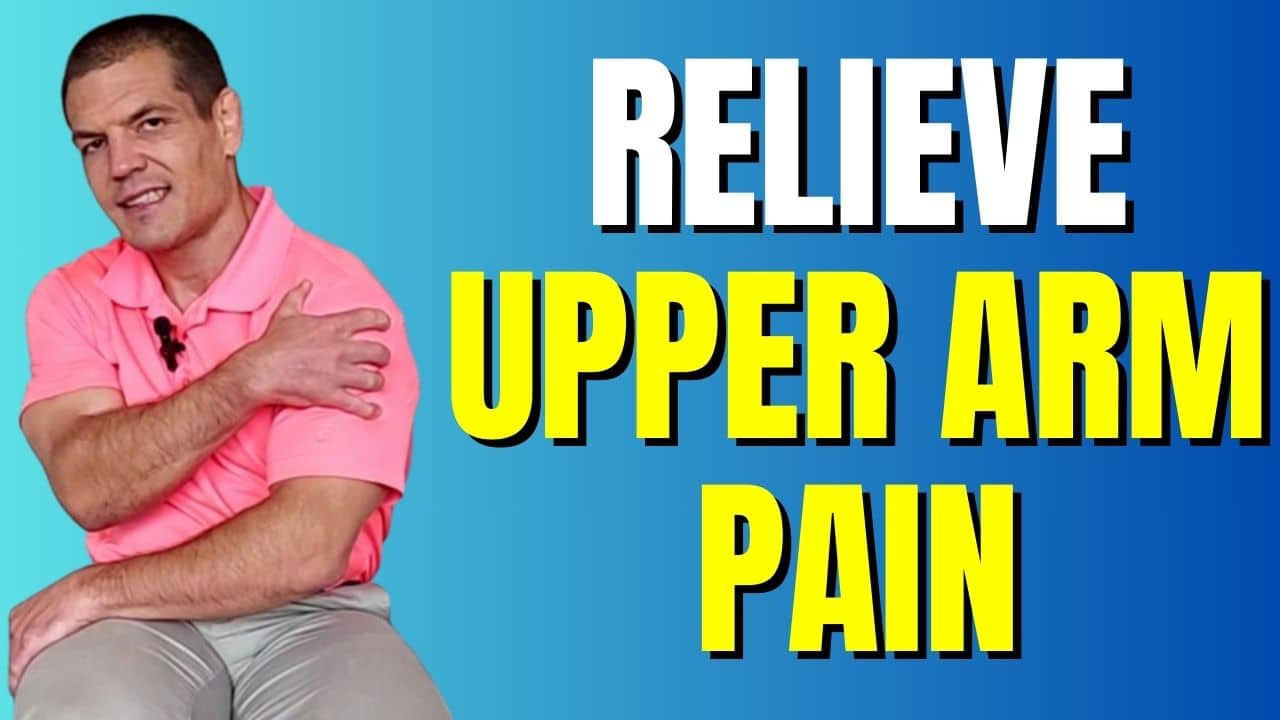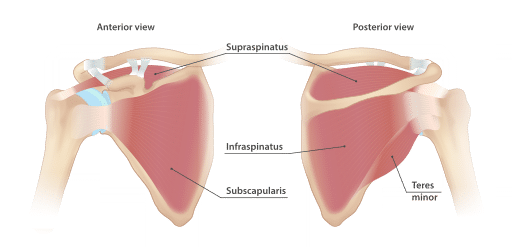Do You Suffer From Upper Arm Pain?
Watch the video below to learn how to relieve upper arm pain from 2 common causes.

What Causes Upper Arm Pain?
Two of the most common causes of upper arm pain are:
- a pinched nerve in your neck (particularly the C5 nerve root)
- a rotator cuff problem (tendinopathy or tear)
Additionally, a fractured arm or fractured humerus can also cause upper arm pain.
However, that typically happens if you've fallen and landed on an outstretched arm or have had direct trauma to your arm.
If you've had either of those, make sure to get an x-ray to ensure you don't have a broken arm.
Interestingly, a lot of times when I see patients in the clinic who come in with a diagnosis of shoulder pain or rotator cuff tendinopathy, they'll say, "My shoulder doesn't hurt; it's my upper arm that hurts."
A lot of times, upper arm pain is the more common symptom of a rotator cuff tendinopathy.
However, in many cases, there are contributions of both the neck and the shoulder combined, but usually one is more problematic than the other.
C5 Nerve Root Problems in the Neck
To distinguish between the two, we perform a couple of movement tests.
Try turning your neck left and right
Go as far as you can one way and notice how much pain you have. Also notice how far you can look. Then go the other direction, and notice if either of those changes your upper arm pain.
If turning your neck changes the pain in your upper arm, it's very likely that your neck is involved.
Additionally, try looking up or down.
If you have degenerative disc disease or spinal stenosis in your neck, looking up may cause some referred pain down into the arm.
Try tipping your head side to side.
This movement can also help determine if your neck is involved based on whether it provokes or relieves the pain.
Rotator Cuff Problems
Next, we perform a couple of movement tests with the arm.
Typically, if you have a rotator cuff problem, some of the most commonly painful movements are:
If moving your shoulder provokes your upper arm pain, then there's a chance that your shoulder or rotator cuff tendons could be involved.
How to Relieve Upper Arm Pain
Now, what you probably really want to know is how to relieve that pain in your upper arm.
The movement tests will often tell you what you need to do.
If turning your neck or moving your shoulder in a certain direction makes your arm pain worse or better, then do the movements that make the symptoms better.
Get arm support
When your arm hangs down, it can pull tension on the nerve roots, creating compression between the vertebrae of your spine. It also pulls on the muscles attaching to your shoulder blade.
Supporting the sore arm with the other arm can help. Getting good arm support by resting your arm on pillows or an armrest can take pressure off the nerve roots in your neck.
Trigger Point Work for Rotator Cuff Muscles
One of the quickest treatments for rotator cuff muscle pain is to do some trigger point work.
The supraspinatus and infraspinatus muscles commonly refer pain to the upper arm. To release a trigger point in the supraspinatus, dig down into it using your fingers or a trigger point cane.
Massage Trigger Point Cane, Body Deep Ti...
31% OffTo release a trigger point in the infraspinatus, use a tennis ball.
Lie on your back and position the tennis ball just behind your shoulder blade. Once you find the sore spot, lay there for about a minute and a half to allow the trigger point to release.
The Sleeper Stretch
The sleeper stretch can help if you have stiffness in your teres minor or infraspinatus.
Position your arm at a 90-degree angle to your body and elbow, and rotate your arm down.
This stretches the muscles in the back of the shoulder and the posterior capsule.
To do a modified version of the sleeper stretch, place your opposite arm on the front of the shoulder and applying downward pressure.
Rotate your arm down toward the bed.
Hold the stretch for a long period of time, ideally 5-10 minutes.
Proper Sleeping Position
Your sleeping position can also play a role in upper arm pain.
Many people notice upper arm pain when they wake up in the morning.
Ensure your neck is adequately supported by pillows, and that your shoulder is not in a position that irritates the rotator cuff tendons at night.
Need Help For Upper Arm Pain?
If you live in the St. Louis area and need help for upper arm pain, tap the button below to request an appointment with one of our orthopedic manual physical therapy specialists.






